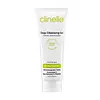What's inside
What's inside
 Key Ingredients
Key Ingredients

 Benefits
Benefits

 Concerns
Concerns

 Ingredients Side-by-side
Ingredients Side-by-side

Water
Skin ConditioningPropanediol
SolventGlycerin
HumectantAvena Sativa Kernel Extract
AbrasiveSqualane
EmollientBetaine
HumectantGluconolactone
Skin ConditioningSalicylic Acid
MaskingPEG-6 Caprylic/Capric Glycerides
EmulsifyingSodium Lauroyl Oat Amino Acids
CleansingPanthenol
Skin ConditioningZinc PCA
HumectantAllantoin
Skin ConditioningAlpha-Glucan Oligosaccharide
CleansingXylitol
HumectantCoco-Glucoside
CleansingAloe Barbadensis Leaf Extract
EmollientLaminaria Ochroleuca Extract
Skin ConditioningAscophyllum Nodosum Extract
Skin ConditioningPhenoxyethanol
PreservativeCetyl Alcohol
EmollientStearyl Alcohol
EmollientEthylhexylglycerin
Skin ConditioningSodium Benzoate
MaskingCitric Acid
BufferingDehydroacetic Acid
PreservativeTrisodium Ethylenediamine Disuccinate
Tocopherol
AntioxidantWater, Propanediol, Glycerin, Avena Sativa Kernel Extract, Squalane, Betaine, Gluconolactone, Salicylic Acid, PEG-6 Caprylic/Capric Glycerides, Sodium Lauroyl Oat Amino Acids, Panthenol, Zinc PCA, Allantoin, Alpha-Glucan Oligosaccharide, Xylitol, Coco-Glucoside, Aloe Barbadensis Leaf Extract, Laminaria Ochroleuca Extract, Ascophyllum Nodosum Extract, Phenoxyethanol, Cetyl Alcohol, Stearyl Alcohol, Ethylhexylglycerin, Sodium Benzoate, Citric Acid, Dehydroacetic Acid, Trisodium Ethylenediamine Disuccinate, Tocopherol
Water
Skin ConditioningDecyl Glucoside
CleansingAcrylates Copolymer
Cocamidopropyl Betaine
CleansingPPG-26-Buteth-26
Skin ConditioningPEG-40 Hydrogenated Castor Oil
EmulsifyingPhenoxyethanol
PreservativePEG-90 Glyceryl Isostearate
CleansingCoco-Glucoside
CleansingGlyceryl Oleate
EmollientChlorphenesin
AntimicrobialSodium Hydroxide
BufferingCitric Acid
BufferingLaureth-2
CleansingBisabolol
MaskingCitrus Limon Peel Oil
MaskingLavandula Hybrida Oil
EmollientO-Cymen-5-Ol
AntimicrobialTocopheryl Acetate
AntioxidantPropylene Glycol
HumectantMenthyl Lactate
MaskingArnica Montana Flower Extract
MaskingHelianthus Annuus Seed Oil
EmollientAloe Barbadensis Leaf Juice
Skin ConditioningTocopherol
AntioxidantHydrogenated Palm Glycerides Citrate
EmollientLecithin
EmollientPanax Ginseng Root Extract
EmollientHedera Helix Extract
AntimicrobialAscorbyl Palmitate
AntioxidantAsiaticoside
AntioxidantAsiatic Acid
Skin ConditioningMadecassic Acid
Skin ConditioningCamellia Sinensis Leaf Extract
AntimicrobialPotassium Sorbate
PreservativeSodium Benzoate
MaskingWater, Decyl Glucoside, Acrylates Copolymer, Cocamidopropyl Betaine, PPG-26-Buteth-26, PEG-40 Hydrogenated Castor Oil, Phenoxyethanol, PEG-90 Glyceryl Isostearate, Coco-Glucoside, Glyceryl Oleate, Chlorphenesin, Sodium Hydroxide, Citric Acid, Laureth-2, Bisabolol, Citrus Limon Peel Oil, Lavandula Hybrida Oil, O-Cymen-5-Ol, Tocopheryl Acetate, Propylene Glycol, Menthyl Lactate, Arnica Montana Flower Extract, Helianthus Annuus Seed Oil, Aloe Barbadensis Leaf Juice, Tocopherol, Hydrogenated Palm Glycerides Citrate, Lecithin, Panax Ginseng Root Extract, Hedera Helix Extract, Ascorbyl Palmitate, Asiaticoside, Asiatic Acid, Madecassic Acid, Camellia Sinensis Leaf Extract, Potassium Sorbate, Sodium Benzoate
 Reviews
Reviews

Ingredients Explained
These ingredients are found in both products.
Ingredients higher up in an ingredient list are typically present in a larger amount.
Citric Acid is an alpha hydroxy acid (AHA) naturally found in citrus fruits like oranges, lemons, and limes.
Like other AHAs, citric acid can exfoliate skin by breaking down the bonds that hold dead skin cells together. This helps reveal smoother and brighter skin underneath.
However, this exfoliating effect only happens at high concentrations (20%) which can be hard to find in cosmetic products.
Due to this, citric acid is usually included in small amounts as a pH adjuster. This helps keep products slightly more acidic and compatible with skin's natural pH.
In skincare formulas, citric acid can:
While it can provide some skin benefits, research shows lactic acid and glycolic acid are generally more effective and less irritating exfoliants.
Most citric acid used in skincare today is made by fermenting sugars (usually from molasses). This synthetic version is identical to the natural citrus form but easier to stabilize and use in formulations.
Read more about some other popular AHA's here:
Learn more about Citric AcidCoco-Glucoside is a surfactant, or a cleansing ingredient. It is made from glucose and coconut oil.
Surfactants help gather dirt, oil, and other pollutants from your skin to be rinsed away.
This ingredient is considered gentle and non-comedogenic. However, it may still be irritating for some.
Learn more about Coco-GlucosidePhenoxyethanol is a preservative that has germicide, antimicrobial, and aromatic properties. Studies show that phenoxyethanol can prevent microbial growth. By itself, it has a scent that is similar to that of a rose.
It's often used in formulations along with Caprylyl Glycol to preserve the shelf life of products.
Sodium Benzoate is a preservative. It's used in both cosmetic and food products to inhibit the growth of mold and bacteria. It is typically produced synthetically.
Both the US FDA and EU Health Committee have approved the use of sodium benzoate. In the US, levels of 0.1% (of the total product) are allowed.
Sodium benzoate works as a preservative by inhibiting the growth of bacteria inside of cells. It prevents the cell from fermenting a type of sugar using an enzyme called phosphofructokinase.
It is the salt of benzoic acid. Foods containing sodium benzoate include soda, salad dressings, condiments, fruit juices, wines, and snack foods.
Studies for using ascorbic acid and sodium benzoate in cosmetics are lacking, especially in skincare routines with multiple steps.
We always recommend speaking with a professional, such as a dermatologist, if you have any concerns.
Learn more about Sodium BenzoateTocopherol (also known as Vitamin E) is a common antioxidant used to help protect the skin from free-radicals and strengthen the skin barrier. It's also fat soluble - this means our skin is great at absorbing it.
Vitamin E also helps keep your natural skin lipids healthy. Your lipid skin barrier naturally consists of lipids, ceramides, and fatty acids. Vitamin E offers extra protection for your skin’s lipid barrier, keeping your skin healthy and nourished.
Another benefit is a bit of UV protection. Vitamin E helps reduce the damage caused by UVB rays. (It should not replace your sunscreen). Combining it with Vitamin C can decrease sunburned cells and hyperpigmentation after UV exposure.
You might have noticed Vitamin E + C often paired together. This is because it is great at stabilizing Vitamin C. Using the two together helps increase the effectiveness of both ingredients.
There are often claims that Vitamin E can reduce/prevent scarring, but these claims haven't been confirmed by scientific research.
Learn more about TocopherolWater. It's the most common cosmetic ingredient of all. You'll usually see it at the top of ingredient lists, meaning that it makes up the largest part of the product.
So why is it so popular? Water most often acts as a solvent - this means that it helps dissolve other ingredients into the formulation.
You'll also recognize water as that liquid we all need to stay alive. If you see this, drink a glass of water. Stay hydrated!
Learn more about Water